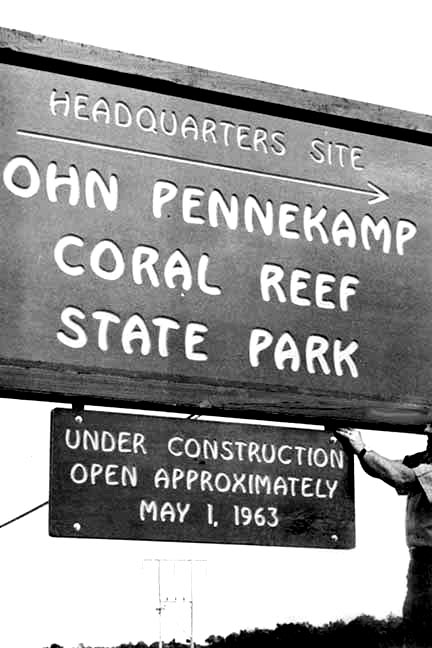 p Park, the Marvin D.
Adams
Waterway and the Key Largo school system have a similar
relationship.
p Park, the Marvin D.
Adams
Waterway and the Key Largo school system have a similar
relationship.Introduction
First
some brief Florida history to set the stage.Florida became a U.S. Territory in 1821 and begin to establish a local government. Counties were created, a transportation system was given priority which allowed businesses to grow. In 1845 it was admitted to the union as the 27th state with a population of 66,500. Its total land was divided between state and federal properties. The federal government, President Lincoln, signed the original Homestead Act into law on May 20, 1862 allowing qualifying person to obtain up to 160 acres with minimum requirements. In the Keys other than Key West the land was not surveyed until the 1870s so homesteading was delayed. After the Civil War a new constitution was made and growth continued. The first act anyway resembling a park was Olustee in recognition of the 1864 Confederate victory in Florida's largest Civil War battle. Others were the Dade Battlefield, Natural Bridge Battlefield and Gamble Plantation. The Florida Legislature authorized the creation of Royal Palm Hammock State Park in 1915 as a Park, and although it remained in private hands until it became part of Everglades National Park (1947); nothing resembled a State Park as known today. The "private hands" mentioned above was the Florida Federation of Women's Clubs and the state was giving them the land. Florida women's groups will remain prominent in promoting parks in Florida for some time.
A 'Florida State Park system' to provide free parks was established by the 1925 Legislature, for the purpose of public recreation or for the preservation of natural beauty or historic association. Unfortunately, no funds were appropriated to implement the law. The Great Depression was a positive thing for the state parks when FDR created of the Civilian Conservation Corps (CCC) in 1933 as part of his New Deal. The CCC provided conservation related work programs for unemployed young men for state parks, of which Florida had none. In order to benefit from the CCC program, Florida got to work and established the Florida Park Service in 1935. Viola', a free labor via the CCC program and real parks were made.
Moving into south Florida and the Everglades, at the right
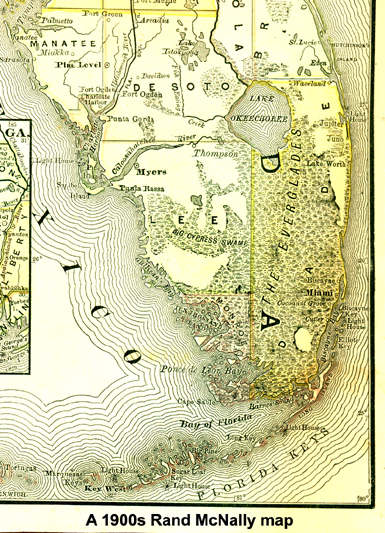 is a circa
1900 Rand McNally map of southern Florida. Most
of southern Florida was either the Big Cypress Swamp or the Everglades.
Although it does not appear so today, most of Miami was swampland that
had to be drained and filled. The
present Miami International Airport was swamp as was all the
surrounding
areas. See map at the right - Click to enlarge.
is a circa
1900 Rand McNally map of southern Florida. Most
of southern Florida was either the Big Cypress Swamp or the Everglades.
Although it does not appear so today, most of Miami was swampland that
had to be drained and filled. The
present Miami International Airport was swamp as was all the
surrounding
areas. See map at the right - Click to enlarge. Several attempts were made to drain and develop the Everglades in the 1880s for development. At the time the first canals built in the Everglades did little harm to the ecosystem as they were unable to drain much of it, but now the effects are taking their toll - mainly salt water intrusion as sea levels are rising. The drainage process was upgraded when Napoleum Bonaparte Broward based the majority of his 1904 political campaign for governor on how drainage would create "The Empire of the Everglades." When elected, Governor Broward ordered the drainage that took place between 1905 and 1910, and it was successful enough that land developers sold tracts for $30 an acre, settling the town of Davie, and developing regions in Lee and Dade counties. The canals also cleared water that made way for huge agricultural fields growing sugarcane. It also dropped the fresh water subsurface table by several feet. It is believe that the canals severed veins of fresh water bring water southward from parts of northern Florida. This water was used by the Native Americans as their drinking water source.
The Florida Land Boom of the 1920s extended the salable land of Miami area westward into the eastern Everglades. Soon new land to sell began to run out about the time that John Pennekamp came to Miami - 1925. By April not only swamps had been made into subdivisions, but much of the eastern Everglades. Almost in its middle was the Royal Palm Estates subdivision being platted and touted to be accessed by ten railroad tracks - more than Miami. With new land not being available to sell/develop, the resale of existing lots became the craze - all on paper with little cash involved. A 10% 'binder fee' was all it took to become an investor. The Miami Daily News published a 504-page issue on July 26, 1926. The same lot was sold, then resold two to three times in one day. The sinking of the Prinz Valermar in the Miami Harbor taking six weeks to clear paused the madness. The September 17-18, 1926 Hurricane burst the land boom bubble and by October most of the 'binder boys' were gone. Miami sustained its now meager economy by pari-mutuel gambling (primarily dog and horse racing) and bootlegging alcoholic products from the Bahamas.
Everglades National Park
It must have been
brewing for some time, but unconfirmed research suggests that in 1922
the
Florida Society of Natural History's first project was some form of a
public
park of the Everglades area. In 1928 David Fairchild was elected the
first president of the Tropic
Everglades Park Board. He wrote: "...when the question of saving the
Everglades
from destruction was proposed, I scarcely dreamed that th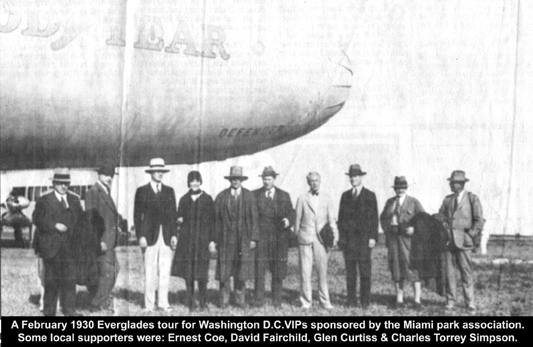 ere could be a
difference of opinion to its answer. I soon discovered what I should
have known before; that prejudice and not wisdom rules
the world." In another manuscript he
wrote, ". . . When will the American public realize it must choose for
it children between tomatoes and plume birds, between something for
their stomachs and something for their souls.
Another peer, Ernest Coe, as chairman of the Tropic Everglades
association of Miami, actively
pursued the creation of a Everglades
National
Park in 1930. In February a host of Washington bigwigs gathered in
Miami for a blimp ride over the Everglades, and lunch at Fairchild's
Kampong estate. Among them was Charley Torrey Simpson and Marjory
Stoneman Douglas wrote an article in The
Miami Herald, page 2. See image at right. The
lady fourth from the left is Florida's and the South's first
Congresswoman, Ruth Bryan
Owen, daughter of William Jennings Bryan. She also is the first woman
U.S. Ambassador when FDR appointed her as Ambassador to Denmark in
1933.
Specific actions for the park is vague, however federal action did
happen
when President Roosevelt
signed the enabling action on May 30, 1934, with the caveat only
when the
property
was turned over to the Department
of Interior. Ernest Coe
continued his
efforts but without significant support other than a few.
ere could be a
difference of opinion to its answer. I soon discovered what I should
have known before; that prejudice and not wisdom rules
the world." In another manuscript he
wrote, ". . . When will the American public realize it must choose for
it children between tomatoes and plume birds, between something for
their stomachs and something for their souls.
Another peer, Ernest Coe, as chairman of the Tropic Everglades
association of Miami, actively
pursued the creation of a Everglades
National
Park in 1930. In February a host of Washington bigwigs gathered in
Miami for a blimp ride over the Everglades, and lunch at Fairchild's
Kampong estate. Among them was Charley Torrey Simpson and Marjory
Stoneman Douglas wrote an article in The
Miami Herald, page 2. See image at right. The
lady fourth from the left is Florida's and the South's first
Congresswoman, Ruth Bryan
Owen, daughter of William Jennings Bryan. She also is the first woman
U.S. Ambassador when FDR appointed her as Ambassador to Denmark in
1933.
Specific actions for the park is vague, however federal action did
happen
when President Roosevelt
signed the enabling action on May 30, 1934, with the caveat only
when the
property
was turned over to the Department
of Interior. Ernest Coe
continued his
efforts but without significant support other than a few.A state sanctioned Everglades National Park Commission was appointed in 1928 primarily with the task of raising money to purchase the property, but it died a slow death - one reason was the Great Depression. Ernest Coe, David Fairchild and Marjory Stoneman Douglas were the founders. What does this have to do with the Upper Keys? The original plans for the park called for the park boundaries to extend east across -and include- the Island of Key Largo as far out as the reef and northwest across the Tamiami Trail (U.S. Highway 41 west of Miami.) and part of the Big Cypress area. Property owners, outdoors men and Monroe County Commissioners opposed such a grandiose park. A large portion of the proposed park was in Monroe County, i.e. The island of Key Largo; therefore, the county would suffer a large dilution of its tax base if this land were withdrawn as well as the gateway to/from the mainland..
In 1946, the Everglades National Park Commission was re-activated with John Pennekamp as its leader. Pennekamp
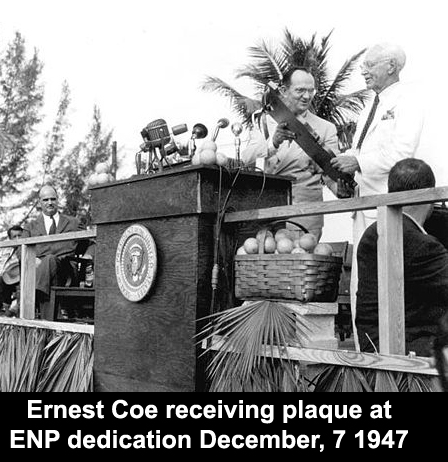 had
the ability to get the
right
people together at the right time. Even more important was his
finessing
the Pork Chopper legislators obtaining the $2 million to give clear
land title to the Department of Interior. Decades of problems were
resolved
and
compromises negotiated. The park's eastern boundary was moved westward
from the reef to where it is today in the
Intracoastal Waterway - Monroe Countian's were relatively pleased as
the Island of Key Largo would not be in a federal park.
President Harry Truman came to
Everglades City and dedicated the Everglades National Park (ENP) on
December 7, 1947. See
photo at the right. Click to enlarge.
had
the ability to get the
right
people together at the right time. Even more important was his
finessing
the Pork Chopper legislators obtaining the $2 million to give clear
land title to the Department of Interior. Decades of problems were
resolved
and
compromises negotiated. The park's eastern boundary was moved westward
from the reef to where it is today in the
Intracoastal Waterway - Monroe Countian's were relatively pleased as
the Island of Key Largo would not be in a federal park.
President Harry Truman came to
Everglades City and dedicated the Everglades National Park (ENP) on
December 7, 1947. See
photo at the right. Click to enlarge.The late John Pennekamp was a former Cincinnati newspaperman and associate editor of The Miami Herald. One of six children, he was born in Cincinnati in 1897, started as a copy boy at the Cincinnati Post at age 14 while working himself through high school, progressed upward to reporter and then the city editor. In WW-I he entered the Army at Camp Sherman, Ohio, contacted Spanish influenza, was given the last rites, but survived. On assignment to Miami from the Post during the 1925 Florida land boom to write a story of two prominent Cincinnati contractors building Coral Gables for George Merrick. During visits to The Miami Herald he was offered the position as its city editor. He later explained, " It was a better climate and more money and . . ." The second 'and' was that he could continue a romance with a former Cincinnatian's daughter, Irene McQuillan, whom he married three months after taking over the city editorship of The Miami Herald in September. They had two sons, Tom and John Jr.
Among Pennekamp's peers, he is probably known best for his 1946 fight all the way to the U.S. Supreme Court, over two editorials and a cartoon allegedly criticizing a well-known local judge. He and the Herald lost the legal appeal to the Florida Supreme Court and were fined $250 and $1,000 respectively, but won at the U.S. Sup
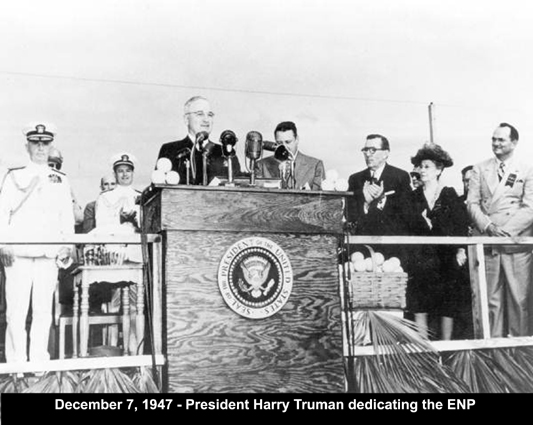 reme Court level, and scored a victory
for freedom of
the
press. His second victory and now becoming better known was his
contribution to the ENP.
reme Court level, and scored a victory
for freedom of
the
press. His second victory and now becoming better known was his
contribution to the ENP. John
Pennekamp Coral Reef State Park
Among conservationists (He insisted that he was not a
conservationist,
but a newspaperman.)
he was, no doubt best known locally for his tireless
efforts
in the establishing of Everglades National Park in 1947, and he was
equally as
dedicated in making the Coral Reef Preserve the success it became.
The relationship between man and the reef continued to worsen in the 1950s. A state law was passed and signs were posted that declared, "No spear fishing from the Monroe County line and the Long Key Viaduct," in 1956. Barges were seen routinely removing large quantities of queen conch and coral. John Pennekamp remembered Ernest Coe's persistence that the coral reef be included in the Everglades National Park, but Coe had to compromise to proceed without it.
In 1957, the condition of the outer reefs was reaching crisis level and Dr. Gilbert Voss, professor of marine biology, U of M actively pursued the saving of the reef. This occurred at a biological conference of 52 scientists in the Everglades National Park. His long list of prominent supporters included Daniel Beard, then superintendent of the park; Charles Brookfield, of the National Audubon Society; Dr. John Davis, of the University of Florida; and Ross Leffler, Assistant Secretary of the U.S. Department of Interior, to name only a few. All had impressive credentials - a coral reef preserve was necessary. The area suggested was the same reef area as Ernest Coe wanted back in the 1930s; therefore, there was precedence for it boundaries. It was all underwater submerged ocean bottom; therefore, terrestrial development land was not a political issue. The group passed a formal resolution for the National Park Service and the Department of Interior to create the preserve. John Pennekamp vividly recalled Coe's vision and rationale for the aquatic preserve, and used his influence with Governor Collins and the Herald to promote it.
Later, our own locals of the Keys like Joe Lance, Herbert Shaw, Herb Alley, Sandy Sprunt, Marvin Adams (Adams Cut), Rep. Bernie Papy, Carlton Adams, the Upper Keys and Miami Kiwanis organizations joined in. John Pennekamp, as chairman of the Florida Board of Parks and Historic Memorials approved the 75 square mile section of the reef - 10% of the entire reef - as a permanent preserve.
Complications delayed the full approval, but in 1959, Florida Governor Leroy Collins and the Florida Internal Improvement Trust gave the Coral Reef Preserve control of the ocean bottom to the Florida three mile limit. The next problem was to get President Eisen
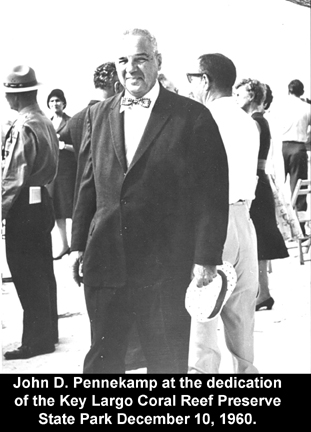 hower to transfer the federal land
(that which is
beyond the three-mile limit out to the 300-foot depth) to the state,
and
this was largely accomplished by Governor Collins and industrialist
Ross
Leffler.
This was finalized by President Eisenhower in March 1960, but there
was no land base approved,
just about 75 square miles of underwater land.
hower to transfer the federal land
(that which is
beyond the three-mile limit out to the 300-foot depth) to the state,
and
this was largely accomplished by Governor Collins and industrialist
Ross
Leffler.
This was finalized by President Eisenhower in March 1960, but there
was no land base approved,
just about 75 square miles of underwater land. Note: Governor Collins was well familiar with the parks system. As a State Senator in 1947, he and two colleagues sponsored a resolution for a joint Senate-House committee for enhancement of the state park system. Later known as the Collins Bill an independent agency called the Board of Parks and Historic Memorials which consolidate all these similar groups under one board. Throughout all of this he worked with John Pennekamp.
On December 10, 1960, Governor Collins at Harry Harris Park dedicated and named the coral reef preserve "John D. Pennekamp Coral Reef State Park" although the dedication program was titled: "Dedication of Key Largo Coral Reef Preserve." (The area now had two names: the Federal as a 'Preserve' and the State as 'Park' and the state had managerial responsibility. The first that Mr. Pennekamp learned of its new name was at the dedication ceremony at Harry Harris Park - MM 92.6. On the back page of the dedication program was only the map of the offshore preserve - much work lay ahead for a bonifide working state park.
Huge crowds were not the norm in the Keys, but this dedication was probably the third largest single gathering of important federal, state and local officials since January 22, 1912, when Henry Flagler arrived on the first train in Key West with about 10,000 in attendance - and this was only the beginning. [The second large gathering was about 5,000 for the dedication of the Florida Keys Memorial, known locally as the Hurricane Monument, in November 1937 at MM 81.6.] In addition to Gov. Collins, Monroe County State Representative Bernie Papy, Ross Leffler, John Robertson (Chairman of the Florida Board of Parks) were present. Note - the only space large enough for the dedication ceremony was the newly made Harris Harris Park near Tavernier (MM 92.5.) itself only two years old
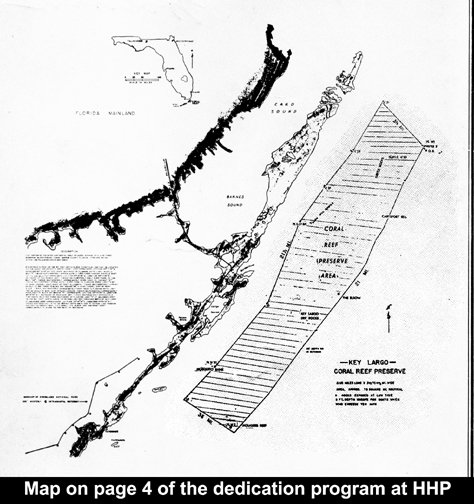 .
.As just a 'preserve' little management would be required, but as a 'Florida State Park' it came under the same management structure as all state parks in the Florida Park Service. The politics of what happened next is obscure, but the actualities are not. A land base for a headquarters and operations was needed. Page 4 of the dedication program only showed a map of the federal preserve area - see right.
John Pennekamp through his friend Marvin Adams who had built the Key Largo Waterway learned of an offer of $141,000 for a 71 acre shoreline track of land. He and Adams went to Key largo and contacted local Key Largo realtor, Joe Lance, with the idea that the state could purchase the parcel for the new park.
With information from Lance, Pennekamp accompanied by Charlie Brookfield visited the owner, Radford Crane according to an August 4, 1966 Pennekamp article in The Miami Herald. John Pennekamp asked Mr. Crane "…if he would delay action on the offer until I could find out whether the state would buy it." Mr. Crane asked “When would that be?” “I am sure the Park Service wants it,” he said “but we will probably will have to wait until the Legislature meets again, then ask for an appropriation.” “Will they make the appropriation?" Crane asked” “Honestly”, Pennekamp said, “I don't know. I don't believe any similar action has ever been taken before, and there is probably only and even chance.” Mr. Crane studied the maps which were on his desk for a few minutes, then looked up: "Forget it, I’ll give it to you. I’ll have to get the consent of my family, but they usually go along with me." All went well and legal procedures were followed.
Later and at a second encounter, John Pennekamp saw Radford Crane at a luncheon and reintroduced himself. "When you have time, I would like to take you down to see the work that is being done on the land that you gave to the Coral Reef Park," Pennekamp said. "I've seen it," Crane replied, "and we want to give you some more. I'll have my attorney call you tomorrow."
The next day Mr. Crane's attorney, Jack Kehoe, presented maps of three quarters of Largo Sound and all of Julia Island (the island between Largo Sound and the Atlantic, named after Julia Pinder), which has 3 miles of oceanfront. The first written account of this small island was by Bernard Romans in 1774 when he referred to it as Sound Point. The appraised value was $2.35 million, the largest gift ever made in the U.S. to a state park. State land records show 71 acres of land in this area transferred from the El Radabob Liquidation Trust, J.G. McKay, Jr., Trustee on March 21, 1961. The meaning of "El Radabob" is: The "El" is for Ellen, the widow of the Pittsburgh industrialist Radford Crane, through whose trust the park was purchased. "Ra" is for Radford Crane; "Da" for son David; "Bob" for son Robert. The research trail in incomplete but it is reported that El Radabob received upward to $3 million in federal tax credits.
(A side note. Radford and Robert Crane and son's involvement in the Keys was not only with Pennekamp Park. They owed the Rimersburg Coal Company of PA which had developed Sugarloaf Shores on Sugarloaf Key. Word is they were involved with strip mining of coal and had a surplus of huge draglines which could and was used in the dredge and fill operations of the Lower Keys. Additional information is needed. jerry142@terranova.net)
A land base for a State Park was possessed; however, there was no access from it to highway U.S. 1, which would be necessary for construction. Three acres between the park and US-1 were granted by Herb and Donna Shaw for an entrance road in the form of a quit claim deed 05-06-1961. Today the original U.S. 1. entrance is closed and is just south of the present park's entrance.
Herbert Shaw came to Miami in 1926 as a musician, a drummer. There he met his wife Donna Stiles, a concert maestra for the University of Miami, and were married 1928. Later, while working at Gulfstream Park, the two were looking for Keys property for their t
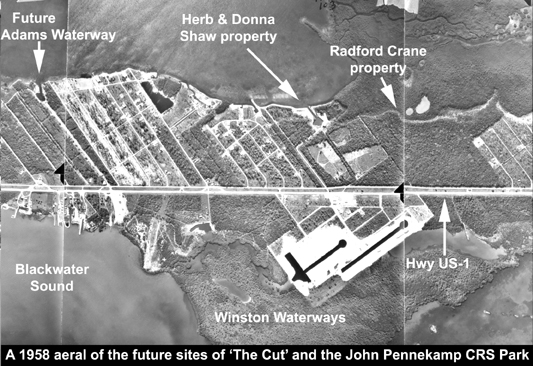 ravel trailer and
ended up buying 57 acres of Florida East Coast Railway land on Key
Largo in 1945. The entire tract had to be purchased as it was
undividable, ar least that was what they were told. An affordable
payment plan was made for them.
ravel trailer and
ended up buying 57 acres of Florida East Coast Railway land on Key
Largo in 1945. The entire tract had to be purchased as it was
undividable, ar least that was what they were told. An affordable
payment plan was made for them. All necessary property were now available so in December 1961 the Monroe County Commission passed a resolution allowing the State Road Department (SRD) to use Monroe County secondary funds for road facilities in the park.
Clearing for the access road and buildings began in January 1962. In August 1962, the Miami engineering company of Connell, Pierce, and Friedman completed the necessary park's master plan. All was now official and actual road construction and marina dredging began the first phases of the master plan. Progress went well and by spring of 1963 Ellison Hardee of O'Leno State Park took residence in April 1963 as the park superintendent. Other personnel followed and performed a lot of hands on labor.
Also in 1962, the January issue of the National Geographic magazine featured an artice "Key Largo Coral Reef - America's First Undersea Park" by Charles Brookfield with photos by Jerry Greenberg. The associated may only depicts the offshore preserve boundaries labeled 'Pennekamp State Park.'
Completion of additional property ownership for the present park was a 'Life Tenancy' sale for the Shaw homesite and grove areas in 1979. The above 1958 aerial photo summarizes the locations at about MM 102.5 as existed in 1958. Across the highway Winston Waterways was starting.
In the aerial photo, the Key Largo Waterway and park did not exist, but the Shaw property had been developed and used for decades. The original grove was prompted by Donna Shaw's grandfather, Frank Stiles. He had developed seven varieties of mangoes and avocados while living in Miami. Samples of some were planted in the grove area. To these trees, The Key Lime was added and a total of about 300 trees were planted. The preparation and planting was overseen by H. S. McKenzie of Tavernier. The actual clearing fo
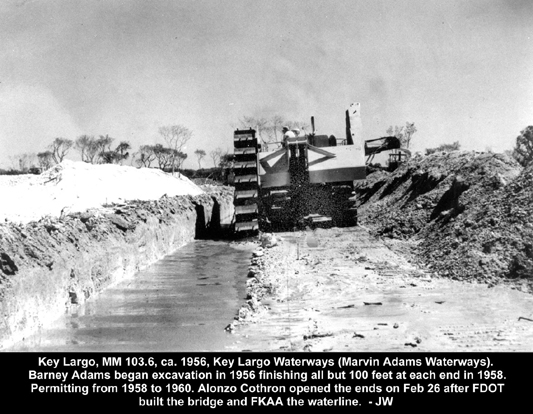 r the grove was
performed
mostly by
the
fathers of Harry Davis Jr., Pete Anderson, and by Emmanuel and Stanley
Clark. If the name of Alexander were added, this would almost be the
beginning
of the black history of Newport (Hibiscus Park today). Hector Clark of
Newport
also planted 35 key lime trees. H. S. McKenzie of Tavernier
dynamited
or drilled
holes
for planting. Hector Clark of Newport
also planted key lime trees, others planted the avocados and mangos,
and
neighboring
children skimmed water from "solution
holes"
to water the newly planted trees. The grove exists today (1999) with
care depending of the superintendent of the park. The grove originally
had a caretaker's house and stables for horses. Herb Shaw was a true
enthusiastic horse lover as he was working at Gulfstream Park at
Hialeah.
r the grove was
performed
mostly by
the
fathers of Harry Davis Jr., Pete Anderson, and by Emmanuel and Stanley
Clark. If the name of Alexander were added, this would almost be the
beginning
of the black history of Newport (Hibiscus Park today). Hector Clark of
Newport
also planted 35 key lime trees. H. S. McKenzie of Tavernier
dynamited
or drilled
holes
for planting. Hector Clark of Newport
also planted key lime trees, others planted the avocados and mangos,
and
neighboring
children skimmed water from "solution
holes"
to water the newly planted trees. The grove exists today (1999) with
care depending of the superintendent of the park. The grove originally
had a caretaker's house and stables for horses. Herb Shaw was a true
enthusiastic horse lover as he was working at Gulfstream Park at
Hialeah.When Hurricane Donna struck the Upper Keys in 1960, many small craft were unable to find safe hurricane anchorage. As a remedy, the Army Corps of Engineers and the Coast Guard deepened the channels of Largo Sound out to the Atlantic Ocean. This provided a storm haven plus access to the John Pennekamp Park for small craft in Largo Sound. This goal was also aided by the approval of the Marvin D. Adams Waterway in 1957 - 1961. At the right see photo of Barney Walden starting to excavate the waterway. The waterway and now deepened ocean channel provided a continuous channel to and from the Atlantic and the Intracoastal Waterway located in Blackwater Sound. John Pennekamp also dedicated the Key Largo Waterway and the Monroe County CommissIon renamed it the Marvin D. Adams Waterway.
This is a side issue. Included in second Crane's land gift was considerable land north of the Marvin D. Adams Waterway. Monroe County wanted to expand the school system in the Upper Keys. The school board, fully expecting to pay a nominal fee, app
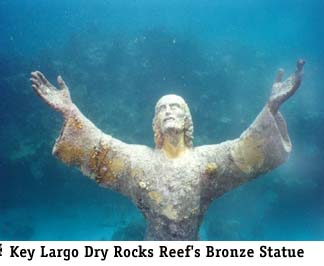 roached the park board for a school
site for the Key
Largo Elementary School. The state, working with the Rand/Crane
families,
had about 27 acres freed from the state park land gift and transferred
it
to Monroe County for the Key Largo Elementary -and later the Middle
School.
roached the park board for a school
site for the Key
Largo Elementary School. The state, working with the Rand/Crane
families,
had about 27 acres freed from the state park land gift and transferred
it
to Monroe County for the Key Largo Elementary -and later the Middle
School. Another event worthy of mentioning, and also sponsored and dedicated on June 29, 1966 by John Pennekamp, is that of the statue "Christ of the Deep." At the same time that the park was gaining popularity, an Italian skin diving enthusiast by the name of Egidi Cressi donated an approximate nine-foot high bronze statue to the Underwater Society of America which had been formed in 1959. The 4,000 pound bronze statue was a duplicate of the "Il Christo Degli Abissi" designed by sculptor Guido Galletti and now resting in the Mediterranean Sea.
The 'Underwater Society of America' offered the statue to the Florida Park Service, who in turn chose Pennekamp Park for its resting place. The Park Advisory Committee of Harry Harris, Herbert Shaw, Eugene Lowe, Sandy Sprunt and Frank Taylor was given the task of choosing one of the many locations within the park. Sandy being the only diver in the group located the Key Largo Dry Rocks area. With 1960 Hurricane Donna in their minds; there was some concern of possible storm damage as the water was relatively shallow, and with the specific support of Eugene Lowe, the others gave their approval; albeit, most of the scientific community were on the negative side.
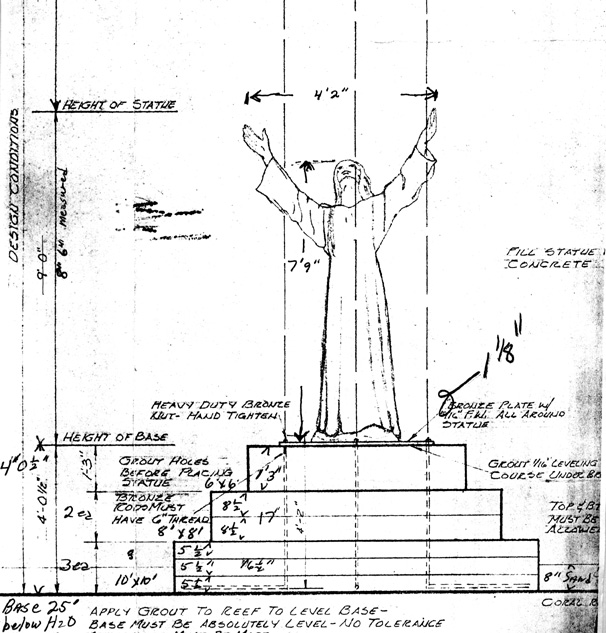
At the right is a portion of construction plans for the concrete base dated 5-28-65. Click to enlarge. It is believed that Maule Industries of Miami built the concrete pieces of the base, hauled them to the park where they were assembled. Others believe they were assembled at the underwater location. The three-tier reinforced concrete base is said to weigh about 160,000-pounds. Local contractor, Alonzo Cothron, barged it to the selected location at Key Largo Dry Rocks and lowered it with a barge mounted crane. Actually the bottom tier is composed of three layers, the second layer of two layers and the top one piece connected together by four brass or bronze J-bolts passing through them and the base of the statue, and huge brass nuts screwed onto the base. The location was hotly debated with the scientific community generally stating that it would not work and the locals stating that it would. I am not certain who made the final ruling, but John Pennekamp gave Eugene Lowe of Tavernier the credit of being correct. Hardee and staff supervised the lowering and securing the statue in position. It was given a final test a short time later when category III Hurricane 'Betsy,' on September 8, 1965, churned up the waters of the inner reef. When all had cleared, the statue stood proud and erect, undamaged and unmoved by the hurricane. Time has verified the location.
Later a bronze plaque was attached to the base by a local dive shop operator in memorial to Michael Kevorkian, a Miami Dive shop operator who ran dive tours off of Key Largo. Another part of Keys history was that official dive shops did not begin until mid or late 1960s.
Since, the seaward extension of the 6-miles has been changed back to the normal 3-mile limit; therefore, the statue is now in waters under federal control. This occured in 1975 when the Key Largo National Marine Sanctuary was established. It and the Looe Key National Marine Sanctuary area's were absorbed in the Florida Keys National Marine Sanctuary on November 16, 1990 by President George H.W. Bush. This protected about 2900 nautical square miles of the Florida Keys. Ernest Coe probably smiled with approval.
One of the highlights of promotion was when Dennis the Menace went to Pennekamp Park i
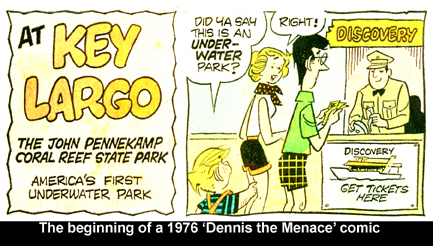 n a 1976 Dennis the Menace comic book - see
below.
n a 1976 Dennis the Menace comic book - see
below.In closing, it should be mentioned that the name of Julia Island was changed to "El Radabob Key." The "El" is for Ellen, the widow of a Pittsburgh industrialist, through whose trust the park was purchased. "Ra" is for Radford Crane; "Da" for son David; "Bob" for son Robert.
John D. Pennekamp passed away June 17, 1978.
In December 2010 John Pennekamp Coral Reef State Park celebrated its 75th anniversary and the Florida Parks Service its 50th anniversary. Many of the John Pennekamp relatives attended.